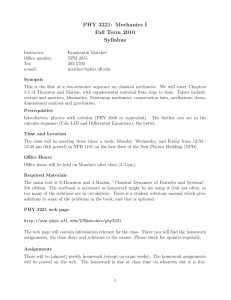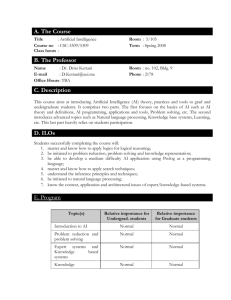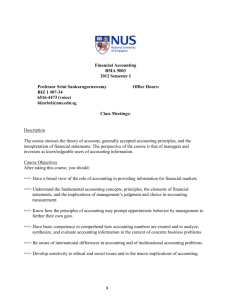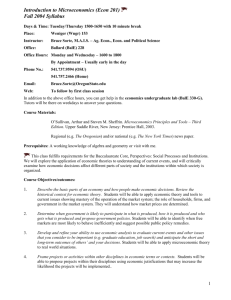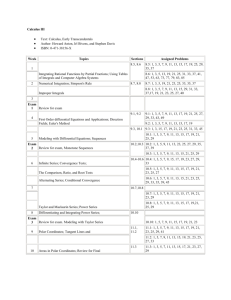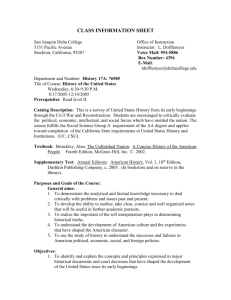Econ 309 01 & 02 Labor Economics Spring 2015
advertisement
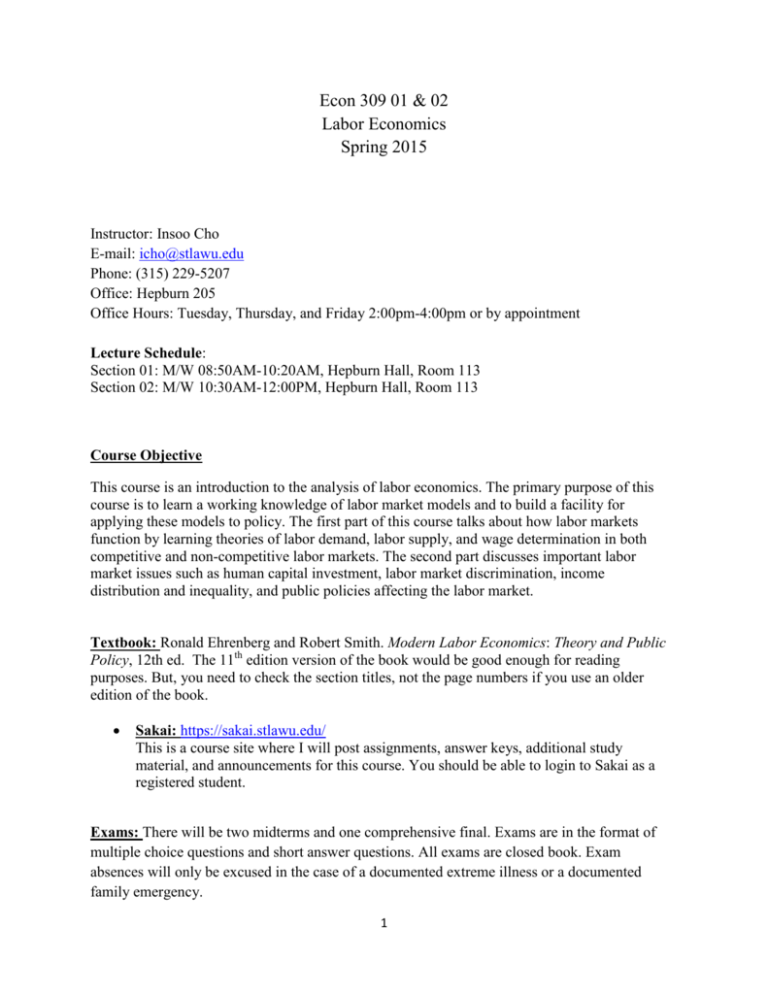
Econ 309 01 & 02 Labor Economics Spring 2015 Instructor: Insoo Cho E-mail: icho@stlawu.edu Phone: (315) 229-5207 Office: Hepburn 205 Office Hours: Tuesday, Thursday, and Friday 2:00pm-4:00pm or by appointment Lecture Schedule: Section 01: M/W 08:50AM-10:20AM, Hepburn Hall, Room 113 Section 02: M/W 10:30AM-12:00PM, Hepburn Hall, Room 113 Course Objective This course is an introduction to the analysis of labor economics. The primary purpose of this course is to learn a working knowledge of labor market models and to build a facility for applying these models to policy. The first part of this course talks about how labor markets function by learning theories of labor demand, labor supply, and wage determination in both competitive and non-competitive labor markets. The second part discusses important labor market issues such as human capital investment, labor market discrimination, income distribution and inequality, and public policies affecting the labor market. Textbook: Ronald Ehrenberg and Robert Smith. Modern Labor Economics: Theory and Public Policy, 12th ed. The 11th edition version of the book would be good enough for reading purposes. But, you need to check the section titles, not the page numbers if you use an older edition of the book. Sakai: https://sakai.stlawu.edu/ This is a course site where I will post assignments, answer keys, additional study material, and announcements for this course. You should be able to login to Sakai as a registered student. Exams: There will be two midterms and one comprehensive final. Exams are in the format of multiple choice questions and short answer questions. All exams are closed book. Exam absences will only be excused in the case of a documented extreme illness or a documented family emergency. 1 Exam dates Midterm 1: Wednesday, February 25 Midterm 2: Wednesday, April 8 The midterms can be rescheduled depending on how much we cover. Final Exam Section 01: Wednesday, May 6th 1:30PM Section 02: Wednesday, May 6th 8:30AM Problem sets: There will be several required problem sets. These problem sets must be handed in by the start of class on the due date. No late homework will be accepted. Submitted problem sets must be neat and legible. Problem sets are a good practice for your exams. Group Work: It can be very helpful to study with a group. This type of cooperative learning is encouraged; however, be sure that you have a thorough understanding of the concepts as well as the mathematical steps used to solve a problem. You must be able to work through the problems on your own. Even if you work together, each student must turn in his or her own work, not just copied solutions. Quizzes: There will also be surprise quizzes during the classes. These are small group activities. You will be given an essay question and work in small groups (e.g., 2~3 students in a group). The purpose of the quizzes is twofold. First, your attendance in the class will be checked randomly through your participation in quizzes. Second, and more importantly, the quizzes review the most important course material, clarify difficult topics, and help you understand your understanding level. We will always review the quizzes in class, so use that opportunity to ask questions. There are absolutely no make-ups for quizzes, so please do not ask for one. The lowest quiz score will be dropped at the end of the semester. Short essay on policy debate (labor market issues) 1. Go to http://www.swcollege.com/bef/policy_debates/econ_debates_labor_markets.html 2. Choose one of the topics listed 3. Summarize the authors’ main arguments in the “Issues and Background” section using your own words. Avoid Plagiarism. Click “Full debate” and author name to access full text of an article. The goal of this summary section is to demonstrate your understanding of both sides of the debates (about 1 page). 4. Add additional details using information provided in the background articles (downloadable for your convenience) listed under “Primary Resources and Data.” You must refer to at least two of these articles and cite them accordingly. 5. Write your own views on the subject you choose (about 1/2~1 page). 2 6. Your last page will be a short bibliography of the downloadable articles you cite (at least two references as indicated above). 7. A good paper will incorporate knowledge learned in class or from the text book. 8. Writing format: - Times New Roman font 12pt - 1 inch margins all around - Double-spaced - Staple everything together - Don’t forget to include your name and section you take - SAVE a copy of your work in case it gets lost 9. Paper due is the last day of class (April 29) Grading Distribution and Scale Midterm 1: 15% Midterm 2: 20% Final exam: 30% Problem sets: 15% Quizzes: 10% Short essay: 10% No late work will be accepted. There will be no extra-credit. There will be no make-up nor re-take exams. Grading scale 4.00 3.75 3.50 3.25 3.00 2.75 2.50 Points 100 – 96 95 – 90 89 – 86 85 – 83 82 – 80 79 – 78 77 – 75 Grading scale 2.25 2.00 1.75 1.50 1.25 1.00 0.00 3 Points 74 – 73 72 – 70 69 – 68 67 – 65 64 – 63 62 – 60 <60 Course Outline Part I: Basics of Labor Market and Unemployment Introduction (Ch.1) Labor Economics: some basic concepts Overview of the Labor Market (Ch.2) Unemployment (Ch.14) Part II: Labor Demand Demand for Labor (Ch. 3) Labor Demand Elasticities (Ch. 4) Frictions in the Labor Market (Ch. 5: 127-151) Part III: Labor Supply Supply of Labor to the Economy: The Decision to Work (Ch. 6) Labor Supply: Household Production, the Family, and the Life Cycle (Ch. 7) Part IV: Human Capital Investment Frictions in the Labor Market (Ch. 5: 152-161) Investments in Human Capital: Education and Training (Ch. 9) Worker Mobility: Migration, Immigration, and Turnover (Ch. 10) Part V: Compensation, Discrimination & Earnings Inequality Compensation (Ch. 8 & 11) Discrimination (Ch. 12) Earnings Inequality (Ch. 15) 4

